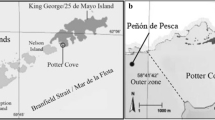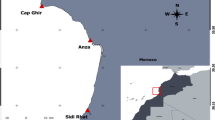Abstract
Oogenesis and gonad development ofCalamus finmarchicus during the winter spring transition in a fjord in Northern Norway were studied. A combination of observations on whole animals (macroscopic), taking advantage of their transparency, and histological sections was used to establish a system of gonad maturation stages, to describe the spawning cycle and to estimate egg production rates from preserved samples. During their development, oocytes change their shape and size, the morphology of the nucleus, and the appearance of the ooplasm. Four oocyte development stages were identified and related to a macroscopic system of four gonad developmental stages (GS) that can be applied to whole stained animals. During gonad development, the macroscopic morphological modifications of the gonads are mainly manifested in an increase in number and size of the oocytes and their distribution in diverticula and oviducts. The maturation processes during the spawning cycle (the period between egg depositions) were described from histological sections of females preserved at regular intervals after egg deposition. The macroscopic GS did not vary during the spawning cycle. This GS was a highly significant indicator for females, which spawned within 24 h after collection at 5°C. Another histological indicator for the last third of the spawning cycle is the appearance of distinct chromosomes, which, however, are only seen in histological sections. For the prediction of egg production rate of aCalanus population, in addition to the number of females spawning, knowledge of clutch size and the interval of clutch deposition is required. Clutch size was determined by counting the number of the oocyte stages to be released during the next spawning event in serial sections of the gonads. There was no significant difference in clutches laid by the females during 5 days before preservation. From the observations it seems that GS 4 predicts females that are ready to spawn within the minimum spawning interval characterisitic for a given temperature. If this holds true, it should be possible to predict in situ egg production rates solely from preserved samples.
Similar content being viewed by others
References
Adiyodi RG (1985) Reproduction and its control. The biology of Crustacea, vol 9. Academic Press, New York, pp 147–215
Adiyodi RG. Subramoniam T (1983) Oogenesis, oviposition and oosorption. In: Adiyodi KG, Adiyodi RG (eds) Reproductive biology of invertebrates. Arthropoda Crustacea, vol 1. Wiley, New York, pp 443–495
Blades-Eckelbarger PI (1986) Aspects of internal anatomy and reproduction in the Copepoda. In: Schriever G, Schminke HK, Shih CT (eds) Proceedings of the 2nd International Conference on Copepoda, 13–17 August 1984, Ottawa. Syllogeus, vol 58. National Musuem of Canada, Ottawa, pp 26–50
Blades-Eckelbarger PI, Youngbluth MJ (1984) The ultrastructure of oogenesis and yolk formation inLabidocera aestiva (Crustacea: Copepoda). J Morphol 179:33–46
Conover RJ (1988) Comparative life histories in the generaCalanus andNeocalanus in high latitudes of the northern hemisphere. Hydrobiologia 167/168:127–142
Diel S, Tande KS (1992) Does the spawning ofCalanus finmarchicus in high latitudes follow a predictable pattern? Mar Biol 113:21–31
Grigg H, Bardwell SJ (1982) Seasonal observations on moulting and maturation in stage V copepodites ofCalanus finmarchicus from the Firth of Clyde. J Mar Biol Assoc UK 62:315–327
Harding JP (1963) The chromosomes ofCalanus finmarchicus andC. helgolandicus. Crustaceana (Leiden) 6:81–88
Harrison KE (1990) The role of nutrition in maturation, reproduction and embryonic development of decapod crustaceans: a review. J Shellfish Res 9:1–28
Heberer G (1930) Die Struktur der Oocyten vonCalanus elongatus Dana mit Bemerkungen über den Bau des weiblichen Genital-apparates. Z Wiss Zool 136:155–194
Hilton IF (1931) The oogenesis ofCalanus finmarchicus. Q J Microsc Sci 74:193–222
Hirche HJ (1990) Egg production ofCalanus finmarchicus at low temperature. Mar Biol 106:53–58
Hirche HJ (in press) The reproductive biology of the marine copepod,Calanus finmarchicus — a review. Ophelia
Hirche HJ, Bohrer RN (1987) Reproduction of the Arctic copepodCalanus glacialis in Fram Strait. Mar Biol 94:11–17
Hirche HJ, Meyer U, Niehoff B (in press) Egg production ofCalanus finmarchicus — effect of food, temperature and season. Mar Biol
Ianora A, Scotto Carlo B di, Mascellaro P (1989) The reproductive biology of the planktonic copepodTemora stylifera. Mar Biol 101:187–194
Karnovsky MJ (1965) A formaldehyde-glutaraldehyde fixative of high osmolarity for use in electron microscopy. J Histochem Cytochem 12:219–221
Kattner G, Hirche HJ, Krause M (1989) Spatial variability in lipid compositon of calanoid copepods from Fram Strait, the Arctic. Mar Biol 102:473–480
Kimoto K, Uye SI, Onbé T (1986) Egg production of a brackish-water calanoid copepodSinocalanus tenellus in relation to food abundance and temperature. Bull Plankton Soc Jpn 33:133–145
Lowe E (1935) On the anatomy of a marine copepod,Calanus finmarchicus (Gunnerus). Trans R Soc Edinb 58:561–603
Marshall SM, Orr AP (1955) The biology of a marine copepodCalanus finmarchicus Gunnerus. Oliver & Boyd, Edinburgh
Marshall SM, Orr AP (1961) On the biology ofCalanus finmarchicus. XII. The phosphorus cycle: excretion, egg production, autolysis. J Mar Biol Assoc UK 41:463–488
Mullin CH (1968) Egg-laying in the planktonic copepodCalanus helgolandicus (Claus). Crustaceana [Suppl] (Leiden) 1:29–34
Papathanassiou E, King PE (1984) Ultrastructural study on gametogenesis of the prawnPalaemon serratus (Pennant). I. Oogenesis. Acta Zool (Stockh.) 65:17–31
Park TS (1966) The biology of a calanoid copepodEpilabidocera amphitrites McMurrich. La Cellule 66:129–251
Plourde S, Runge JA (1993) Reproduction of the planktonic copepodCalanus finmarchicus in the Lower St. Lawrence Estuary: relation to the cycle of phytoplankton production and evidence for aCalanus pump. Mar Ecol Prog Ser 102:217–227
Raymont JEG, Krishnaswamy S, Woodhouse MA, Griffin RL (1974) Studies on the fine structure of Copepoda. Observations onCalanus finmarchicus (Gunnerus). Proc R Soc Lond Ser B 185:409–424
Razouls S (1974) Maturite sexuelle et fecondite chez la femelle deTemora stylifera, copepode pelagique (Copepoda Calanoida). Arch Zool Exp Gen 115:387–399
Razouls S, Nival P, Nival S (1987) Development of the genital system in the copepodid stages of the calanoid copepodTemora stylifera Dana. J Mar Biol Assoc UK 67:653–661
Razouls S, Razouls C, Huntley M (1991) Development and expression of sexual maturity in femaleCalanus pacificus (Copepoda: Calanoida) in relation to food quality. Mar Biol 110:65–74
Runge JA (1984) Egg production of the marine, planktonic copepod,Calanus pacificus Brodsky: laboratory observations. J Exp Mar Biol Ecol 74:53–66
Runge JA (1985) Egg production rates ofCalanus finmarchicus in the sea of Nova Scotia. Arch Hydrobiol 21:33–40
Runge JA (1987) Measurement of egg production rate ofCalanus finmarchicus from preserved samples. Can J Fish Aquat Sci 44:2009–2012
Sachs L (1978) Angewandte Statistik. Springer, Berlin Heidelberg New York
Sargent JR, Falk-Petersen S (1988) The lipid biochemistry of calanoid copepods. Hydrobiologia 167/168:101–114
Tande KS, Hopkins CCE (1981) Ecological investigations of the zooplankton community of Balsfjorden, northern Norway: the genital system inCalanus finmarchicus and the role of gonad development in overwintering strategy. Mar Biol 63:159–164
Author information
Authors and Affiliations
Rights and permissions
About this article
Cite this article
Niehoff, B., Hirche, HJ. Oogenesis and gonad maturation in the copepodCalanus finmarchicus and the prediction of egg production from preserved samples. Polar Biol 16, 601–612 (1996). https://doi.org/10.1007/BF02329058
Received:
Accepted:
Issue Date:
DOI: https://doi.org/10.1007/BF02329058




